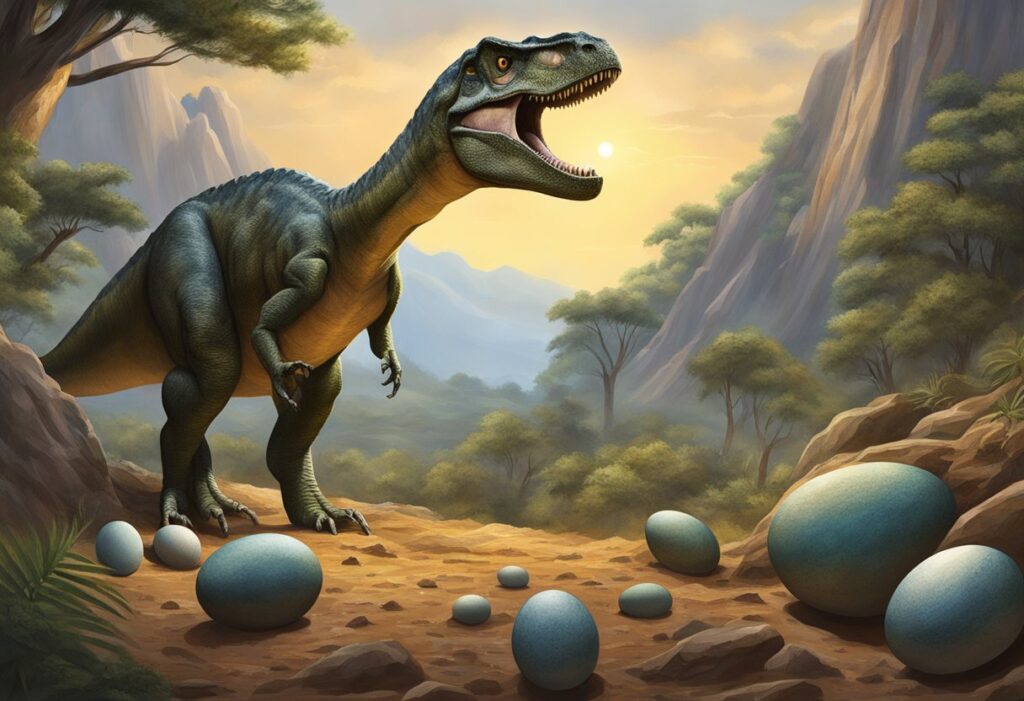Dinosaur eggs have always been a subject of fascination for scientists, paleontologists, and the general public alike. These eggs provide a glimpse into the reproductive behavior of these prehistoric creatures, as well as their life history and ecology. The question of how big dinosaur eggs were is one that has intrigued researchers for decades.

Dinosaur eggs came in a wide range of sizes, depending on the species of the dinosaur that laid them. Some eggs were as small as a few inches in diameter, while others were as large as a basketball. The size of the egg had a direct impact on the size of the dinosaur that laid it, as well as the size of the hatchling that emerged from it.
Key Takeaways
- Dinosaur eggs came in a variety of sizes, depending on the species of the dinosaur that laid them.
- The size of the egg had a direct impact on the size of the dinosaur that laid it, as well as the size of the hatchling that emerged from it.
- The study of dinosaur eggs provides valuable insights into the reproductive behavior, life history, and ecology of these prehistoric creatures.
General Size and Characteristics of Dinosaur Eggs

Dinosaur eggs come in various sizes and shapes, depending on the species. According to Adventuredinosaurs.com, dinosaur eggs can range from 8 to 12 inches long and two to five inches wide. However, some species like the Macroelongatoolithus have been found to have eggs up to 18 inches long and six inches wide.
Variations Across Species
The size and shape of dinosaur eggs vary significantly across species. For example, the smallest dinosaur eggs belong to the Mussaurus, which were only about two inches long and one inch wide. On the other hand, the largest dinosaur eggs belong to the Hypselosaurus, and they were up to 13 inches long and eight inches wide.
In addition to size, the texture and thickness of the eggshells also vary across species. Some eggs have smooth and thin shells, while others have rough and thick shells. The texture and thickness of the eggshells are believed to have been influenced by the nesting environments of the dinosaurs.
Comparison to Modern-Day Reptile Eggs
Dinosaur eggs are similar to modern-day reptile eggs in many ways. They are both covered in a protective shell that helps to keep the developing embryo safe. However, there are some differences between dinosaur eggs and modern-day reptile eggs.
For example, dinosaur eggs were generally larger than modern-day reptile eggs. The largest modern-day reptile eggs belong to the Komodo dragon, and they are only about four inches long and two inches wide. Additionally, the eggshells of modern-day reptile eggs are generally thinner than the eggshells of dinosaur eggs.
Overall, dinosaur eggs were a fascinating aspect of these prehistoric creatures. The variations in size, shape, texture, and thickness of the eggshells provide insight into the nesting habits and environments of dinosaurs.
Fossil Evidence and Discovery

Major Fossil Finds
Dinosaur eggs have been found all over the world, from the United States to Argentina to Mongolia. Some of the most significant fossil finds have come from the Gobi Desert in Mongolia, where the first scientifically recognized dinosaur egg fossils were discovered in 1923 by an American Museum of Natural History crew while looking for evidence of early humans. These eggs were initially attributed to the locally abundant herbivore Protoceratops, but are now known to be Oviraptor eggs.
Another significant find was made in China’s Henan Province in 1993, where a nest of 20 dinosaur eggs was discovered. The eggs were identified as belonging to the oviraptorosaur species, which were small, bird-like dinosaurs that lived during the Late Cretaceous period.
Preservation and Analysis Techniques
Fossilized dinosaur eggs are typically preserved in sedimentary rock, which can provide valuable information about the environment in which the eggs were laid. Paleontologists can use various techniques to analyze the eggs, including CT scanning and chemical analysis.
CT scanning has been used to study the internal structure of dinosaur eggs without damaging the fossils. This technique has revealed details about the thickness and shape of the eggshells, as well as the size and position of the embryo inside the egg.
Chemical analysis has also been used to study dinosaur eggs. By analyzing the chemical composition of the eggshell, researchers can determine the type of dinosaur that laid the egg, as well as the environment in which it lived. For example, a study published in the journal Scientific Reports used chemical analysis to identify the type of dinosaur that laid a clutch of eggs found in Argentina. The researchers found that the eggs belonged to a sauropod species, which were long-necked herbivores that lived during the Late Cretaceous period.
Overall, the fossil evidence and discovery of dinosaur eggs has provided valuable insights into the reproductive behavior and evolution of these fascinating creatures.
Eggshell Structure and Composition

Dinosaur eggs come in a variety of shapes and sizes, ranging from small and round to large and elongated. However, regardless of their size and shape, all dinosaur eggs share a similar structure and composition.
Microstructure Details
The eggshell of a dinosaur egg consists of several layers, including an outermost layer called the cuticle, a middle layer called the mammillary layer, and an innermost layer called the cone layer. The cuticle is a thin, waxy layer that helps to protect the eggshell from damage and dehydration. The mammillary layer is made up of small, spherical structures called mammillae, which provide structural support to the eggshell. The cone layer is a dense, calcified layer that helps to protect the developing embryo inside the egg.
In addition to these layers, the eggshell of a dinosaur egg also contains a series of pores. These pores allow for the exchange of gases between the developing embryo and the outside environment. The size and distribution of these pores can vary depending on the species of dinosaur that laid the egg.
Material Composition
The eggshell of a dinosaur egg is primarily composed of calcium carbonate, which is the same material that makes up the shells of modern bird eggs. However, the eggshells of some dinosaur species also contain other minerals, such as iron and zinc. These minerals can give the eggshell a unique color or texture.
The thickness of a dinosaur eggshell can also vary depending on the species of dinosaur that laid the egg. Some species, such as the hadrosaurs, had relatively thin eggshells, while others, such as the theropods, had much thicker eggshells.
Overall, the structure and composition of dinosaur eggshells provide valuable insights into the reproductive strategies and embryonic development of these ancient creatures. By studying the microstructure details and material composition of dinosaur eggs, scientists can better understand how these eggs were formed and how the developing embryos inside them were able to survive.
Nesting Behaviors and Reproduction

Dinosaurs laid eggs as part of their reproductive strategy. The size of dinosaur eggs varied greatly depending on the species. Some dinosaur eggs were as small as a chicken egg, while others were as large as a basketball.
Nesting Sites
Dinosaurs laid their eggs in a variety of locations. Some species, such as the oviraptor, built nests out of twigs and vegetation. Other species, like the hadrosaur, laid their eggs in open nests on the ground. Some dinosaurs even laid their eggs in burrows.
Parental Care Indicators
Fossil evidence suggests that some dinosaurs exhibited parental care. For example, fossilized nests of Maiasaura have been found with adult specimens nearby, indicating that the adults were caring for the eggs and young. In addition, fossilized embryos have been found inside some dinosaur eggs, suggesting that the parents were incubating the eggs.
Overall, the nesting behaviors and reproductive strategies of dinosaurs varied greatly depending on the species. However, the discovery of fossilized nests and eggs provides valuable insight into the lives of these ancient creatures.
Embryonic Development

Dinosaur eggs are fascinating specimens that provide valuable insights into the reproductive strategies and embryonic development of these ancient creatures. Understanding the embryonic development of dinosaur eggs is key to unraveling the mysteries of their existence.
Growth Stages in the Egg
The growth stages in dinosaur eggs can be divided into three main phases: the pre-ovulatory phase, the ovulatory phase, and the post-ovulatory phase. During the pre-ovulatory phase, the egg is formed in the female’s body and undergoes a series of changes that prepare it for fertilization. The ovulatory phase is when the egg is released from the female’s body and fertilized. Finally, during the post-ovulatory phase, the egg undergoes embryonic development.
The duration of each phase varies depending on the species of dinosaur. For example, the pre-ovulatory phase for sauropods could last up to two years, while the post-ovulatory phase for theropods could last as little as 40 days.
Oxygen Supply and Waste Removal
During embryonic development, the dinosaur embryo requires a constant supply of oxygen and the removal of waste products. The eggshell plays a critical role in this process by allowing for gas exchange between the embryo and the outside environment.
The thickness and structure of the eggshell can vary depending on the species of dinosaur. For example, the eggshells of theropods were thinner and more porous than those of sauropods, which likely had thicker eggshells to protect their larger eggs.
In conclusion, understanding the embryonic development of dinosaur eggs is essential to understanding the reproductive strategies and life cycles of these ancient creatures. The growth stages in the egg and the role of the eggshell in oxygen supply and waste removal are just a few of the fascinating aspects of dinosaur egg development.
Impact of Egg Size on Dinosaur Life History

Dinosaur eggs come in various sizes, ranging from a few centimeters to over a foot long. The size of the egg has a significant impact on the life history of the dinosaur, affecting hatchling size, survival, and reproductive strategies.
Hatchling Size and Survival
The size of the egg determines the size of the hatchling. Larger eggs produce larger hatchlings, which have a better chance of survival. For example, the eggs of sauropods, the largest dinosaurs, were enormous, up to a foot long and weighing several kilograms. The hatchlings that emerged from these eggs were correspondingly large and better able to withstand predation and environmental stress.
Smaller eggs, on the other hand, produce smaller hatchlings that are more vulnerable to predators and environmental stress. For example, the eggs of theropods, such as Tyrannosaurus rex, were relatively small, about the size of a cantaloupe. The hatchlings that emerged from these eggs were correspondingly small and more vulnerable to predation and environmental stress.
Reproductive Strategies
The size of the egg also affects reproductive strategies. Dinosaurs with larger eggs tended to lay fewer eggs per clutch, while those with smaller eggs laid more eggs per clutch. This trade-off between egg size and clutch size reflects the different reproductive strategies of dinosaurs.
For example, sauropods laid relatively few eggs per clutch, but each egg was large and produced a correspondingly large hatchling. This strategy allowed sauropods to invest more energy in each offspring, increasing the chances of survival and reducing the need for frequent reproduction.
Theropods, on the other hand, laid many small eggs per clutch, but each egg produced a correspondingly small hatchling. This strategy allowed theropods to produce many offspring quickly and frequently, increasing the chances of survival and maintaining a large population.
In conclusion, the size of dinosaur eggs had a significant impact on the life history of dinosaurs, affecting hatchling size, survival, and reproductive strategies. Larger eggs produced larger hatchlings with a better chance of survival, while smaller eggs produced smaller hatchlings that were more vulnerable to predation and environmental stress. The trade-off between egg size and clutch size reflects the different reproductive strategies of dinosaurs.
Paleoecological Significance

Dinosaur eggs were a crucial aspect of the Mesozoic ecosystem. They played a significant role in the food web, and their size and shape reveal a lot about the reproductive strategies of different species. In this section, we will discuss the paleoecological significance of dinosaur eggs, including their ecosystem roles and interactions and evolutionary implications.
Ecosystem Roles and Interactions
Dinosaur eggs were an essential food source for many predators, including other dinosaurs and small mammals. The size of the eggs and the number of eggs laid by each species influenced the number of offspring that survived to adulthood. For example, some species laid small numbers of large eggs, while others laid large numbers of small eggs. The former strategy resulted in fewer offspring but increased the chances of survival due to the larger size of the hatchlings. The latter strategy resulted in more offspring but increased the chances of predation due to the smaller size of the hatchlings.
Evolutionary Implications
The size and shape of dinosaur eggs provide valuable insights into the reproductive strategies of different species. For example, some species, such as theropods, laid elongated eggs, while others, such as sauropods, laid rounder eggs. The shape of the eggs influenced the way the embryos developed and the size of the hatchlings. Additionally, the discovery of fossilized eggs has allowed scientists to study the evolution of dinosaur reproductive systems over time.
Overall, the study of dinosaur eggs has provided significant insights into the ecology and evolution of these creatures. Through the analysis of egg size, shape, and number, scientists can gain a better understanding of the reproductive strategies of different species and their interactions within the ecosystem.
Comparative Analysis
Dinosaur Eggs vs. Bird Eggs
Dinosaur eggs are similar to bird eggs in many ways. Both have a hard, calcified shell that protects the developing embryo inside. However, dinosaur eggs are generally much larger than bird eggs. For example, the largest known bird egg belonged to the extinct elephant bird and was about 7 inches long, while some dinosaur eggs were over 18 inches long [1].
Another difference between dinosaur and bird eggs is the shape. Bird eggs are generally more symmetrical and oval-shaped, while dinosaur eggs can be more elongated or even spherical. This difference in shape may be related to differences in the way the eggs were laid or incubated by the parent animals.
Egg Size and Dinosaur Cladistics
The size of dinosaur eggs can also provide insight into the evolutionary relationships between different dinosaur groups. For example, some studies have suggested that the size and shape of dinosaur eggs can be used to determine whether a particular species of dinosaur was a theropod (a group that includes birds and other carnivorous dinosaurs) or a sauropod (a group of long-necked herbivorous dinosaurs).
One study found that theropod eggs tended to be elongated and pointed at one end, while sauropod eggs were more spherical and had a smoother surface texture [1]. This suggests that the two groups of dinosaurs may have had different reproductive strategies, with theropods laying their eggs in nests and sauropods burying their eggs in the ground.
In conclusion, a comparative analysis of dinosaur and bird eggs reveals similarities and differences in their structure and development. Dinosaur eggs are generally much larger than bird eggs and can be more elongated or spherical in shape. The size and shape of dinosaur eggs can also provide insight into the evolutionary relationships between different dinosaur groups, particularly between theropods and sauropods.
[1] Adventuredinosaurs.com. (n.d.). Cracking The Mystery: How Big Are Dinosaur Eggs Really? Retrieved April 15, 2024, from https://adventuredinosaurs.com/how-big-are-dinosaur-eggs-surprising-sizes-key-species/
[2] PrehistoricSaurus. (n.d.). Dinosaur Eggs: Structure and Development. Retrieved April 15, 2024, from https://prehistoricsaurus.com/paleobiology/reproduction/dinosaur-eggs-structure-and-development/
